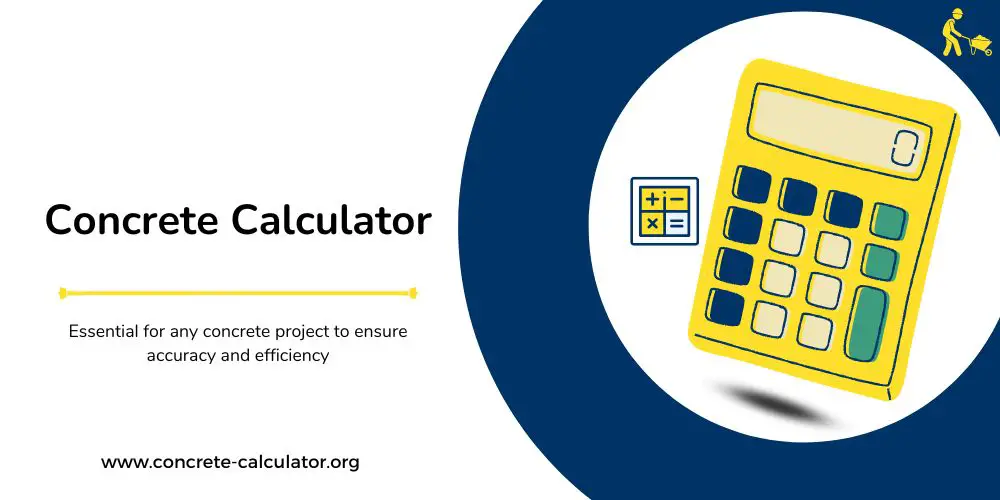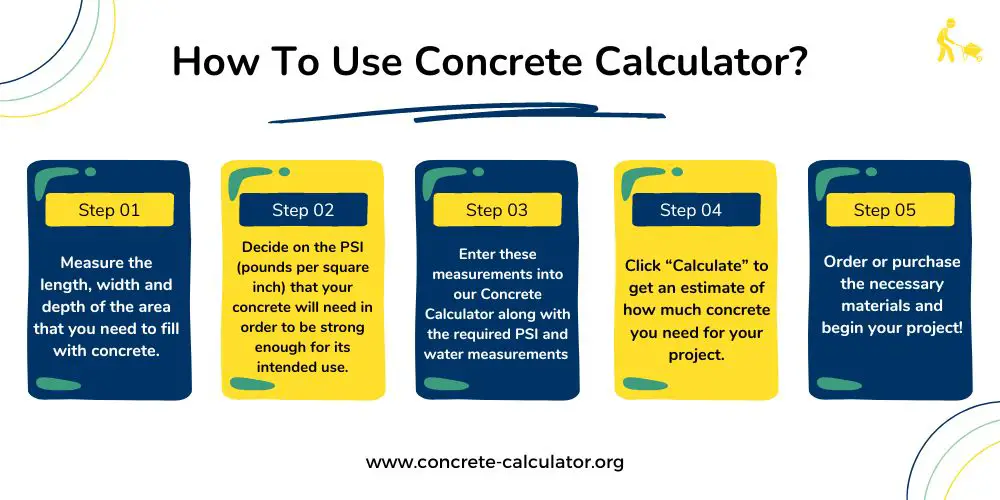Looking to take on a concrete project? Let our Concrete Calculator help you determine the exact amount of material needed. With its estimates, it will be easier for you to avoid buying too little or having extra after your job is done—saving time and money!
A cement calculator is a valuable tool for any concrete project as it helps to ensure both accuracy and efficiency. Knowing exactly how much cement, gravel, sand, and water you need will help make sure your project runs smoothly without any hiccups. It removes the need for guesswork in mixing cement and helps prevent waste caused by incorrect measurements.
Make sure to use our Concrete Calculator before you start your cement project and be sure to have the exact amount of cement necessary for a successful job. By using it, you can achieve precise measurements and optimal outcomes.

Concrete Calculator
It works by taking into account the desired depth, length, and width of the cement along with its strength, or PSI. It then calculates the precise amount of cement needed for your project. By using our concrete slab calculator, you can be assured that your concrete will be strong enough to withstand all kinds of weather conditions and remain durable for years to come.
Calculating concrete is an essential aspect of any construction project. As a construction professional, I have seen firsthand the importance of accurately calculating the amount of concrete needed for a project. Not only does it ensure that the project stays within budget, but it also ensures that the right amount of materials is on hand to complete the project on schedule.
One of the biggest challenges when calculating concrete is ensuring that you have enough to complete the project without having excess materials left over. This can be especially difficult on larger projects, where the amount of concrete needed can be significant.
In my experience, one of the best ways to ensure that you have the right amount of concrete is to work with a concrete weight calculator. These tools can help you determine the exact amount of concrete needed for your project, taking into account factors such as the size of the project and the type of concrete being used.
Another important aspect of calculating concrete is ensuring that the right mix of materials is used. The strength and durability of the concrete are determined by the mix of materials used, so it is important to ensure that the right mix is used for the specific application.
Moreover, In my career in construction, I have realized that working with a reputable concrete supplier is key to ensuring that you have quality materials for your project. They can guide the best mix of materials for your project and can also provide you with a sample for testing before the project begins.
The formula for calculating the concrete is simple:
length x width x thickness = cubic meters
This equation allows you to easily calculate the amount of cement needed for your project or even cylinder with just a few pieces of information. It’s important to note that you may need different amounts of concrete depending on what type of job it is and how strong you need the cement to be.
For example, if you need concrete for a patio or walkway, you’ll usually use a PSI of 4,000 while foundations and walls often require a higher PSI (5,000-6,000). Make sure to double-check the PSI requirements for your particular project before calculating the concrete!
The amount of concrete you need will depend on the size and shape of your project as well as the type of material you’re using. Generally speaking, it’s best to overestimate how much concrete you’ll need to avoid any problems due to a lack of materials or resources.
It’s also wise to factor in a 10-30% waste allowance when ordering materials, as it’s not uncommon to experience some degree of waste during the mixing and pouring process. When ordering from a supplier, make sure to identify whether or not they will accept returns as not all suppliers do.
Also Read: How Long Does Concrete Take To Dry?

How To Use Concrete Calculator
A yard is a unit of measure for concrete that equals one cubic yard of material. A cubic yard of concrete mix will cover an area 9 feet by 9 feet by one inch thick.
To calculate concrete yards, you’ll need to know the measurement of your project in feet and also the thickness of the material. Once you have those two values, divide them by 27 (the number of cubic feet in a yard) to determine the number of cubic yardage of concrete needed for your project.
For example, if you need a footing that is 6’ long, 12’ wide, and 8” deep, the equation would look like this: (6 x 12) x 8 = 576 cubic feet. Then divide that number by 27, which is the number of cubic feet in a yard, and you’ll get 21.33 cubic yards of concrete needed for your project.
Another important thing is Base Fill Material, Base fill material is used as a foundation for many construction projects such as driveways, walkways, and patios. It’s important to accurately measure the area that you need to fill to get an accurate estimate of how much material will be required.
Normally, for a base fill material, it’s best to use a ratio of one part sand to four parts gravel.
It’s important to accurately calculate the weight of concrete for several reasons. First, you want to make sure that you’ve ordered or purchased enough material to complete your project. Secondly, it’s important to consider the structural integrity of your project and ensure that it is strong enough to hold up whatever you’re building or installing.
But, when it comes to calculating the weight of concrete, there are a few things to consider. For example, if you’re using pre-mix concrete, the weight will be based on the cubic feet of material that was used in the mix. If you’re mixing your concrete, then you must factor in the weight of each of the materials (cement, sand, and gravel) that are used in the mix.
Once you know the exact weight of your concrete, you can use this information to determine whether or not your project will be structurally sound. This is especially useful for larger projects, as the weight of the concrete can have a huge impact on the project’s overall stability.
The number of bags of concrete you need depends on the size and shape of your project as well as the type of material you’re using.
You can use our Concrete Calculator to calculate how much concrete you need. Simply input the desired length, width, and thickness of the concrete along with its strength (PSI) and it will give you the exact amount of concrete needed for your project.
Yes, there is a difference between concrete and cement. Cement is the binding agent used to make concrete, while concrete is the mixture of cement, water, and other materials such as sand or gravel.
The amount of concrete you mix per m3 depends on the strength requirements of the job. You will need approximately one part water to five parts cement by weight. For example, if you need to mix 50kg of cement, you will need approximately 10 liters of water.
For a 24×24 slab, you would need approximately 11.6 cubic meters of concrete. However, this amount may vary depending on the thickness of the slab.
To calculate how many cement bags you need, divide the total amount of concrete required (in cubic meters) by 0.0347. This will give you the approximate number of 50kg cement bags needed for your project.
The 20 30 40 rule in concrete is used to determine the amount of cement, sand, and gravel that should be mixed for a given strength of concrete. The rule states that for a given strength of concrete, the mix should contain 20 parts cement, 30 parts sand, and 40 parts gravel or crushed stone.
There are approximately 29-31 50kg bags of concrete in an m3. The exact number may vary depending on the type and strength of concrete being used.
There are approximately 58-60 20kg bags of concrete in a cubic meter. The exact number may vary on the quality of the concrete.
To calculate cubic yards of concrete, you need to know the measurement of your project in feet and also the thickness of the material. Once you have these two values, divide them by 27 (the number of cubic feet in a yard). The result will tell you how many cubic yards of concrete
Concrete Pad Calculations are essential for any construction project. Whether you’re building a foundation for a new home or constructing a pad for an outdoor shed, knowing the exact amount of concrete needed for the job will help you plan and budget accordingly.
To calculate Portland cement, you need to know the weight of your concrete mix. Once you have this value, multiply it by 0.0347. This will give you the approximate weight of Portland cement needed for that mix.
Also See these tools:

I am John Doe, a licensed civil engineer and concrete expert. I received my degree in Civil Engineering from Washington State University and have been working in the field for 15 years. Based in Seattle, WA, I specialize in concrete projects and calculations. I have a passion for sharing my knowledge and experience through my website concrete-